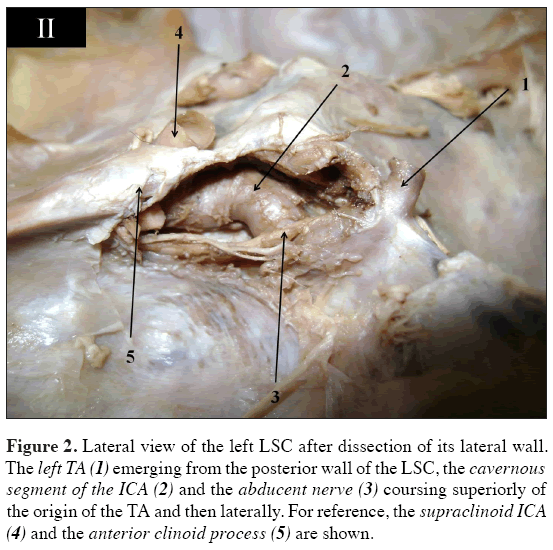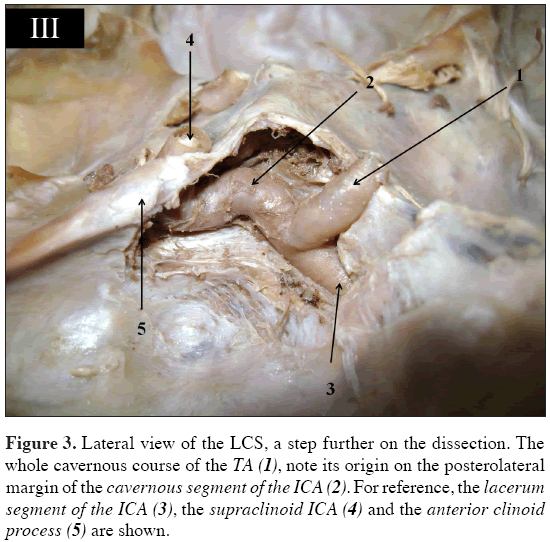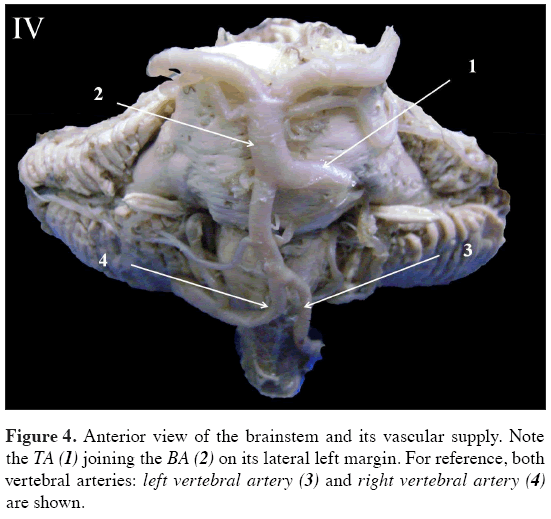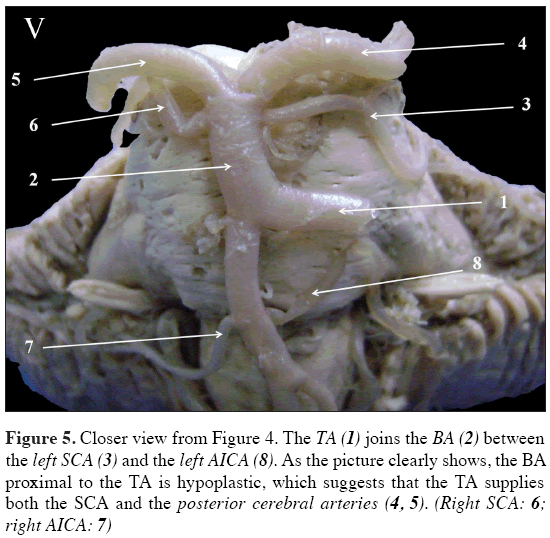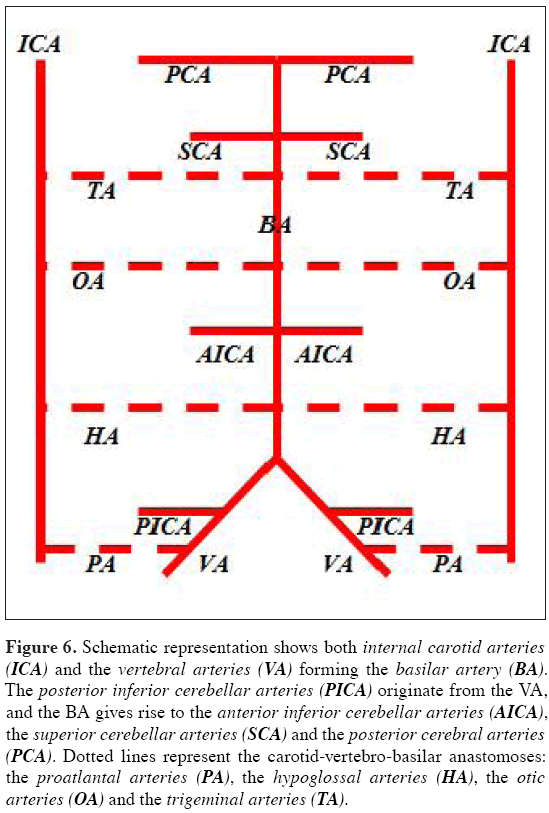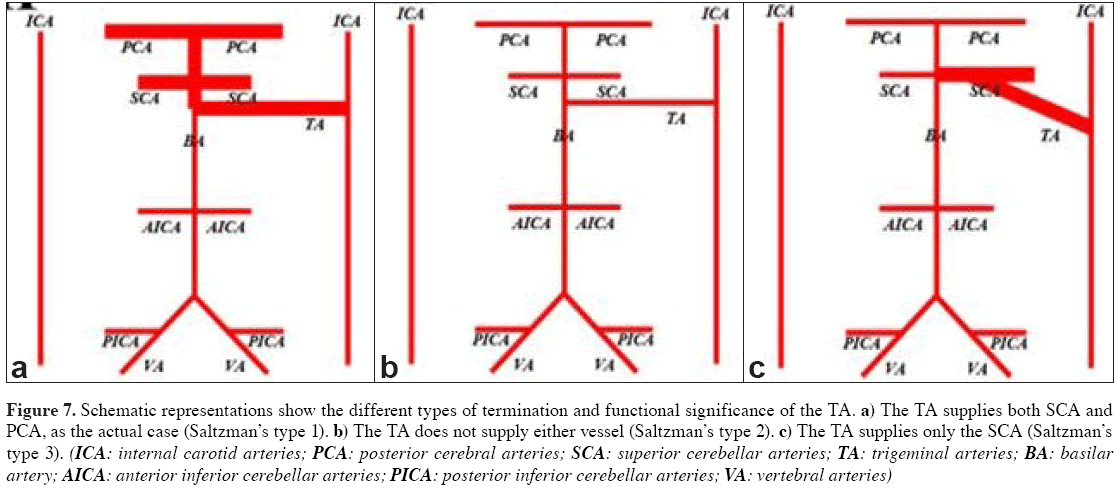Persistent trigeminal artery: case report
Alejandro M. Russo*, María C. Sienra
Departamento de Anatomía, Prof. Dr. Víctor Soria, Facultad de Medicina, Universidad de la República, Montevideo, Uruguay.
- *Corresponding Author:
- Br. Alejandro M. Russo
Ayudante de Clase (Grado 1), Departamento de Anatomía, Prof. Dr. Víctor Soria, Facultad de Medicina, Universidad de la República, Montevideo, Uruguay.
Tel: +598 27117079
E-mail: aleru86@gmail.com
Date of Received: February 11th, 2011
Date of Accepted: August 16th, 2011
Published Online: September 24th, 2011
© IJAV. 2011; 4: 157–160.
[ft_below_content] =>Keywords
persistent trigeminal artery, carotid-basilar anastomosis, intracranial vessels, embryology, anatomic variation
Introduction
The primitive trigeminal, otic, hypoglossal, and proatlantal intersegmental arteries are persistent fetal anastomoses between the carotid and vertebro-basilar circulations [1]. The trigeminal artery (TA) is the most cephalic and anterior of these arteries, its name comes from its proximity to the trigeminal ganglion [2]. It represents the most frequently reported persistent carotid-basilar anastomosis [3].
Since the development of cerebral angiograms more and more angiographic reports of the trigeminal artery and the rest of the carotid-basilar anastomoses have appeared worldwide [4]. These reports are usually associated to intracranial pathologic conditions, such as Moyamoya disease, arterio-venous malformations and intracranial aneurysms. However, very few anatomic reports can be found.
From its origin in the cavernous segment (C4) of the internal carotid artery (ICA), the TA may penetrate the sella turcica near the clivus to join the basilar artery (BA); or it may travel lateral to the sella turcica before arriving to the BA [5]. Its termination is also variable, between the anterior inferior cerebellar artery (AICA) and the superior cerebellar artery (SCA), or directly on the SCA, or less frequently on the posterior inferior cerebellar artery (PICA).
We present and discuss a case of TA found in an adult male cadaver.
Case Report
The TA was found during dissection of formalin fixed 60-year-old male cadaver. After removal of the brain, a left TA was noticed by the authors, exiting the ipsilateral latero-sellar compartment (LSC). This vessel emanated from the posterior wall of the left LSC, and was immediately medial to the dorsal root of the trigeminal nerve and the opening of Meckel’s cave; and just lateral to the entrance of the abducent nerve in the LSC (Dorello´s canal) (Figure 1). The lateral wall of the LSC was dissected in order to expose the C4 segment of the ICA and TA (Figures 2, 3). The TA was found to originate from the postero-lateral aspect of the C4 segment of the ICA (Figure 3). The TA diameter was 5 mm, which was the same diameter as the C4 segment of the ICA. The length of the vessel was 23 mm; the cavernous segment was shorter, 9 mm, while the subarachnoid segment was 14 mm. In its cavernous segment, the TA was intimately related to the adjacent nerves; the abducent nerve was superior to the origin of the TA and the coursed laterally to the ICA (Figure 2), as previously reported [3]. The oculomotor and troclear nerves coursed superiorly while the ophthalmic and maxillar nerves coursed laterally. Finally, the TA joined the BA by its left margin, between the origin of the AICA and the SCA (Figures 4, 5). Clearly the BA below the TA was hypoplastic (Figure 5), which suggests that the TA was supplying both SCA and the posterior cerebral artery’s territory. No macroscopic vessels were originated from the TA, and no other variations were found in the arteries supplying the central nervous system.
Figure 1: Posterior view of the posterior wall of the left LSC. Left TA (1) emerging lateral to the abducent nerve (2) and medial to the dorsal root of the trigeminal nerve (3). For reference, the facial and vestibulocochlear nerves inside the internal acoustic meatus (4) and the dorsum sella (5) are shown.
Figure 2: Lateral view of the left LSC after dissection of its lateral wall. The left TA (1) emerging from the posterior wall of the LSC, the cavernous segment of the ICA (2) and the abducent nerve (3) coursing superiorly of the origin of the TA and then laterally. For reference, the supraclinoid ICA (4) and the anterior clinoid process (5) are shown.
Figure 3: Lateral view of the LCS, a step further on the dissection. The whole cavernous course of the TA (1), note its origin on the posterolateral margin of the cavernous segment of the ICA (2). For reference, the lacerum segment of the ICA (3), the supraclinoid ICA (4) and the anterior clinoid process (5) are shown.
Figure 5: Closer view from Figure 4. The TA (1) joins the BA (2) between the left SCA (3) and the left AICA (8). As the picture clearly shows, the BA proximal to the TA is hypoplastic, which suggests that the TA supplies both the SCA and the posterior cerebral arteries (4, 5). (Right SCA: 6; right AICA: 7)
Discussion
The key to understanding the anatomy and functional significance of the carotid-vetebrobasilar anastomosis is to understand the embryology of the cerebral arterial supply. During the 4 mm embryo stage, the forebrain is supplied by the carotid system, while the longitudinal neural arteries, which will originate the BA, supply the hindbrain. These longitudinal arteries are supplied by the carotid arteries via 3 presegmental arterial anastomoses, the TA, the otic artery, the hypoglossal artery and one intersegmental anatomosis, the proatlantal artery (Figure 6). During the 6 mm stage, an anastomosis forms between the distal ICA and the corresponding longitudinal neural artery, which becomes the posterior communicating artery. Subsequently, the presegmental arteries and the proatlantal artery regress and obliterate [1]. Failure on this mechanisms, explains the persistence of the carotid-vertebrobasilar anastomosis in the adult. For further details on the embryology of the cranial arteries we encourage the reader to read the detailed study of Padget [6].
Figure 6: Schematic representation shows both internal carotid arteries (ICA) and the vertebral arteries (VA) forming the basilar artery (BA). The posterior inferior cerebellar arteries (PICA) originate from the VA, and the BA gives rise to the anterior inferior cerebellar arteries (AICA), the superior cerebellar arteries (SCA) and the posterior cerebral arteries (PCA). Dotted lines represent the carotid-vertebro-basilar anastomoses: the proatlantal arteries (PA), the hypoglossal arteries (HA), the otic arteries (OA) and the trigeminal arteries (TA).
The TA represents the fetal artery supplying the cranial portion of the brainstem and the last of the persistent fetal arteries to regress during development [2]. Its incidence is about 0.2%; however, considering undiagnosed and unreported cases, the incidence probably approaches 1%. It represents about 85% of all carotid-basilar anastomoses [1].
Salas et al. [1] distinguished two types of TA regarding their relationships to the abducent nerve; a lateral or petrosal and medial or sphenoidal. When the artery courses lateral to the abducent nerve intradurally, it arises from the postero-lateral aspect of the C4 segment of the ICA. Conversely, when the TA arises from the postero-medial aspect of the C4 segment of the ICA, they course medial to the abducent nerve, the so-called medial type [8]. Taking this classification into account, the TA presented in this report corresponds to the petrosal or lateral variant.
In addition, angiographic studies have classified the TA regarding its termination; two major variants are found [9]. The Saltzman type 1 TA, joins the BA between the SCA and the AICA. The BA proximal to the junction is usually hypoplastic. The posterior communicating arteries are absent or poorly opacified. The trigeminal artery supplies both posterior cerebral arteries and SCA (Figure 7a). The Saltzman type 2 TA, joins the BA between the SCA and the AICA. The posterior communicating arteries are present and supply the posterior cerebral arteries (Figure 7b). Finally, the TA may directly join a cerebellar artery, sometimes referred to as Saltzman type 3, which is a very uncommon variation [1] (Figure 7c). According to this classification the TA we studied corresponds to Saltzman type 1 TA. Although we lack of functional studies to confirm this statement, the morphology of the BA upward and below the TA, clearly suggests that the latter supplied both SCA and both posterior cerebral arteries.
Figure 7: Schematic representations show the different types of termination and functional significance of the TA. a) The TA supplies both SCA and PCA, as the actual case (Saltzman’s type 1). b) The TA does not supply either vessel (Saltzman’s type 2). c) The TA supplies only the SCA (Saltzman’s type 3). (ICA: internal carotid arteries; PCA: posterior cerebral arteries; SCA: superior cerebellar arteries; TA: trigeminal arteries; BA: basilar artery; AICA: anterior inferior cerebellar arteries; PICA: posterior inferior cerebellar arteries; VA: vertebral arteries)
From a clinical point of view, the TA may be associated with intracranial aneurysms, Moyamoya disease, cavernous-carotid fistulas [10]; although some authors argue that a large variety of the associated neurologic findings are coincidental [1].
In conclusion, we present an anatomic case of a left TA, according to the discussion above; it corresponds to a TA type lateral and Saltzman’s type 1. This vessel may be associated with intracranial conditions, and it should be taken in consideration by the clinician or radiologist when interpreting a cerebral angiogram.
References
- Luh GY, Dean BL, Tomsick TA, Wallace RC. The persistent fetal carotid-vertebrobasilar anastomoses. AJR Am J Roentgenol. 1999; 172: 1427–1432.
- Tubbs RS, Shoja MM, Salter EG, Oakes WJ. Cadaveric findings of persistent fetal trigeminal arteries. Clin Anat. 2007; 20: 367–370.
- Battista RA, Kwartler JA, Martinez DM. Persistent trigeminal artery as a cause of dizziness. Ear Nose Throat J. 1997; 76: 43–45.
- Martínez F, Sgarbi N, Laza S. Arteria trigeminal primitiva persistente: presentación de un caso arteriográfico. Rev Neurocir. 2001; 4: 106–110. (Spanish)
- Suttner N, Mura J, Tedeschi H, Ferreira MA, Wen HT, de Oliveira E, Rhoton AL Jr. Persistent trigeminal artery: A unique anatomic specimen-analysis and therapeutic implications. Neurosurgery. 2000; 47: 428–433.
- Padget DH. The development of the cranial arteries in the human embryo. Contr Embryol. 1948; 32: 205–261.
- Salas E, Ziyal IM, Sekhar LN, Wright DC. Persistent trigeminal artery: an anatomic study. Neurosurgery. 1998; 43: 557–562.
- Tubbs RS, Verma K, Riech S, Mortazavi MM, Shoja MM, Loukas M, Curé JK, Zurada A, Cohen-Gadol AA. Persistent fetal intracranial arteries: a comprehensive review of anatomical and clinical significance. J. Neurosurg. 2011; 114: 1127–1134.
- Saltzman GF. Patent primitive trigeminal artery studied by cerebral angiography. Acta Radiol. 1959; 51: 329–336.
- Cheng WC, Wang AD. Carotid-cavernous sinus fistula associated with a primitive trigeminal artery. Neurosurgery. 1990; 27: 802–805.
Alejandro M. Russo*, María C. Sienra
Departamento de Anatomía, Prof. Dr. Víctor Soria, Facultad de Medicina, Universidad de la República, Montevideo, Uruguay.
- *Corresponding Author:
- Br. Alejandro M. Russo
Ayudante de Clase (Grado 1), Departamento de Anatomía, Prof. Dr. Víctor Soria, Facultad de Medicina, Universidad de la República, Montevideo, Uruguay.
Tel: +598 27117079
E-mail: aleru86@gmail.com
Date of Received: February 11th, 2011
Date of Accepted: August 16th, 2011
Published Online: September 24th, 2011
© IJAV. 2011; 4: 157–160.
Abstract
Anastomosis found in the adulthood between the carotid and vertebro-basilar systems, apart from the posterior communicating artery, are extremely infrequent and are due to the persistence of vessels that joined both systems during the fetal period. This carotid-vertebrobasilar anastomosis are the trigeminal, otic, hypoglossal and proatlantal arteries. We report in this paper a case of a persistant trigeminal artery found in an adult male cadaver. In this case, it rose from the cavernous segment of the left internal carotid artery and traveled posteriorly to join the basilar artery between the origin of the anterior inferior cerebellar artery and the superior cerebellar artery, corresponding to a trigeminal artery type I according to Saltzman´s classification. Although it has low frequency of presentation, the trigeminal artery is associated with several pathologic conditions, and should be considered by the clinician and radiologist when enterpreting cerebral angiograms.
-Keywords
persistent trigeminal artery, carotid-basilar anastomosis, intracranial vessels, embryology, anatomic variation
Introduction
The primitive trigeminal, otic, hypoglossal, and proatlantal intersegmental arteries are persistent fetal anastomoses between the carotid and vertebro-basilar circulations [1]. The trigeminal artery (TA) is the most cephalic and anterior of these arteries, its name comes from its proximity to the trigeminal ganglion [2]. It represents the most frequently reported persistent carotid-basilar anastomosis [3].
Since the development of cerebral angiograms more and more angiographic reports of the trigeminal artery and the rest of the carotid-basilar anastomoses have appeared worldwide [4]. These reports are usually associated to intracranial pathologic conditions, such as Moyamoya disease, arterio-venous malformations and intracranial aneurysms. However, very few anatomic reports can be found.
From its origin in the cavernous segment (C4) of the internal carotid artery (ICA), the TA may penetrate the sella turcica near the clivus to join the basilar artery (BA); or it may travel lateral to the sella turcica before arriving to the BA [5]. Its termination is also variable, between the anterior inferior cerebellar artery (AICA) and the superior cerebellar artery (SCA), or directly on the SCA, or less frequently on the posterior inferior cerebellar artery (PICA).
We present and discuss a case of TA found in an adult male cadaver.
Case Report
The TA was found during dissection of formalin fixed 60-year-old male cadaver. After removal of the brain, a left TA was noticed by the authors, exiting the ipsilateral latero-sellar compartment (LSC). This vessel emanated from the posterior wall of the left LSC, and was immediately medial to the dorsal root of the trigeminal nerve and the opening of Meckel’s cave; and just lateral to the entrance of the abducent nerve in the LSC (Dorello´s canal) (Figure 1). The lateral wall of the LSC was dissected in order to expose the C4 segment of the ICA and TA (Figures 2, 3). The TA was found to originate from the postero-lateral aspect of the C4 segment of the ICA (Figure 3). The TA diameter was 5 mm, which was the same diameter as the C4 segment of the ICA. The length of the vessel was 23 mm; the cavernous segment was shorter, 9 mm, while the subarachnoid segment was 14 mm. In its cavernous segment, the TA was intimately related to the adjacent nerves; the abducent nerve was superior to the origin of the TA and the coursed laterally to the ICA (Figure 2), as previously reported [3]. The oculomotor and troclear nerves coursed superiorly while the ophthalmic and maxillar nerves coursed laterally. Finally, the TA joined the BA by its left margin, between the origin of the AICA and the SCA (Figures 4, 5). Clearly the BA below the TA was hypoplastic (Figure 5), which suggests that the TA was supplying both SCA and the posterior cerebral artery’s territory. No macroscopic vessels were originated from the TA, and no other variations were found in the arteries supplying the central nervous system.
Figure 1: Posterior view of the posterior wall of the left LSC. Left TA (1) emerging lateral to the abducent nerve (2) and medial to the dorsal root of the trigeminal nerve (3). For reference, the facial and vestibulocochlear nerves inside the internal acoustic meatus (4) and the dorsum sella (5) are shown.
Figure 2: Lateral view of the left LSC after dissection of its lateral wall. The left TA (1) emerging from the posterior wall of the LSC, the cavernous segment of the ICA (2) and the abducent nerve (3) coursing superiorly of the origin of the TA and then laterally. For reference, the supraclinoid ICA (4) and the anterior clinoid process (5) are shown.
Figure 3: Lateral view of the LCS, a step further on the dissection. The whole cavernous course of the TA (1), note its origin on the posterolateral margin of the cavernous segment of the ICA (2). For reference, the lacerum segment of the ICA (3), the supraclinoid ICA (4) and the anterior clinoid process (5) are shown.
Figure 5: Closer view from Figure 4. The TA (1) joins the BA (2) between the left SCA (3) and the left AICA (8). As the picture clearly shows, the BA proximal to the TA is hypoplastic, which suggests that the TA supplies both the SCA and the posterior cerebral arteries (4, 5). (Right SCA: 6; right AICA: 7)
Discussion
The key to understanding the anatomy and functional significance of the carotid-vetebrobasilar anastomosis is to understand the embryology of the cerebral arterial supply. During the 4 mm embryo stage, the forebrain is supplied by the carotid system, while the longitudinal neural arteries, which will originate the BA, supply the hindbrain. These longitudinal arteries are supplied by the carotid arteries via 3 presegmental arterial anastomoses, the TA, the otic artery, the hypoglossal artery and one intersegmental anatomosis, the proatlantal artery (Figure 6). During the 6 mm stage, an anastomosis forms between the distal ICA and the corresponding longitudinal neural artery, which becomes the posterior communicating artery. Subsequently, the presegmental arteries and the proatlantal artery regress and obliterate [1]. Failure on this mechanisms, explains the persistence of the carotid-vertebrobasilar anastomosis in the adult. For further details on the embryology of the cranial arteries we encourage the reader to read the detailed study of Padget [6].
Figure 6: Schematic representation shows both internal carotid arteries (ICA) and the vertebral arteries (VA) forming the basilar artery (BA). The posterior inferior cerebellar arteries (PICA) originate from the VA, and the BA gives rise to the anterior inferior cerebellar arteries (AICA), the superior cerebellar arteries (SCA) and the posterior cerebral arteries (PCA). Dotted lines represent the carotid-vertebro-basilar anastomoses: the proatlantal arteries (PA), the hypoglossal arteries (HA), the otic arteries (OA) and the trigeminal arteries (TA).
The TA represents the fetal artery supplying the cranial portion of the brainstem and the last of the persistent fetal arteries to regress during development [2]. Its incidence is about 0.2%; however, considering undiagnosed and unreported cases, the incidence probably approaches 1%. It represents about 85% of all carotid-basilar anastomoses [1].
Salas et al. [1] distinguished two types of TA regarding their relationships to the abducent nerve; a lateral or petrosal and medial or sphenoidal. When the artery courses lateral to the abducent nerve intradurally, it arises from the postero-lateral aspect of the C4 segment of the ICA. Conversely, when the TA arises from the postero-medial aspect of the C4 segment of the ICA, they course medial to the abducent nerve, the so-called medial type [8]. Taking this classification into account, the TA presented in this report corresponds to the petrosal or lateral variant.
In addition, angiographic studies have classified the TA regarding its termination; two major variants are found [9]. The Saltzman type 1 TA, joins the BA between the SCA and the AICA. The BA proximal to the junction is usually hypoplastic. The posterior communicating arteries are absent or poorly opacified. The trigeminal artery supplies both posterior cerebral arteries and SCA (Figure 7a). The Saltzman type 2 TA, joins the BA between the SCA and the AICA. The posterior communicating arteries are present and supply the posterior cerebral arteries (Figure 7b). Finally, the TA may directly join a cerebellar artery, sometimes referred to as Saltzman type 3, which is a very uncommon variation [1] (Figure 7c). According to this classification the TA we studied corresponds to Saltzman type 1 TA. Although we lack of functional studies to confirm this statement, the morphology of the BA upward and below the TA, clearly suggests that the latter supplied both SCA and both posterior cerebral arteries.
Figure 7: Schematic representations show the different types of termination and functional significance of the TA. a) The TA supplies both SCA and PCA, as the actual case (Saltzman’s type 1). b) The TA does not supply either vessel (Saltzman’s type 2). c) The TA supplies only the SCA (Saltzman’s type 3). (ICA: internal carotid arteries; PCA: posterior cerebral arteries; SCA: superior cerebellar arteries; TA: trigeminal arteries; BA: basilar artery; AICA: anterior inferior cerebellar arteries; PICA: posterior inferior cerebellar arteries; VA: vertebral arteries)
From a clinical point of view, the TA may be associated with intracranial aneurysms, Moyamoya disease, cavernous-carotid fistulas [10]; although some authors argue that a large variety of the associated neurologic findings are coincidental [1].
In conclusion, we present an anatomic case of a left TA, according to the discussion above; it corresponds to a TA type lateral and Saltzman’s type 1. This vessel may be associated with intracranial conditions, and it should be taken in consideration by the clinician or radiologist when interpreting a cerebral angiogram.
References
- Luh GY, Dean BL, Tomsick TA, Wallace RC. The persistent fetal carotid-vertebrobasilar anastomoses. AJR Am J Roentgenol. 1999; 172: 1427–1432.
- Tubbs RS, Shoja MM, Salter EG, Oakes WJ. Cadaveric findings of persistent fetal trigeminal arteries. Clin Anat. 2007; 20: 367–370.
- Battista RA, Kwartler JA, Martinez DM. Persistent trigeminal artery as a cause of dizziness. Ear Nose Throat J. 1997; 76: 43–45.
- Martínez F, Sgarbi N, Laza S. Arteria trigeminal primitiva persistente: presentación de un caso arteriográfico. Rev Neurocir. 2001; 4: 106–110. (Spanish)
- Suttner N, Mura J, Tedeschi H, Ferreira MA, Wen HT, de Oliveira E, Rhoton AL Jr. Persistent trigeminal artery: A unique anatomic specimen-analysis and therapeutic implications. Neurosurgery. 2000; 47: 428–433.
- Padget DH. The development of the cranial arteries in the human embryo. Contr Embryol. 1948; 32: 205–261.
- Salas E, Ziyal IM, Sekhar LN, Wright DC. Persistent trigeminal artery: an anatomic study. Neurosurgery. 1998; 43: 557–562.
- Tubbs RS, Verma K, Riech S, Mortazavi MM, Shoja MM, Loukas M, Curé JK, Zurada A, Cohen-Gadol AA. Persistent fetal intracranial arteries: a comprehensive review of anatomical and clinical significance. J. Neurosurg. 2011; 114: 1127–1134.
- Saltzman GF. Patent primitive trigeminal artery studied by cerebral angiography. Acta Radiol. 1959; 51: 329–336.
- Cheng WC, Wang AD. Carotid-cavernous sinus fistula associated with a primitive trigeminal artery. Neurosurgery. 1990; 27: 802–805.





